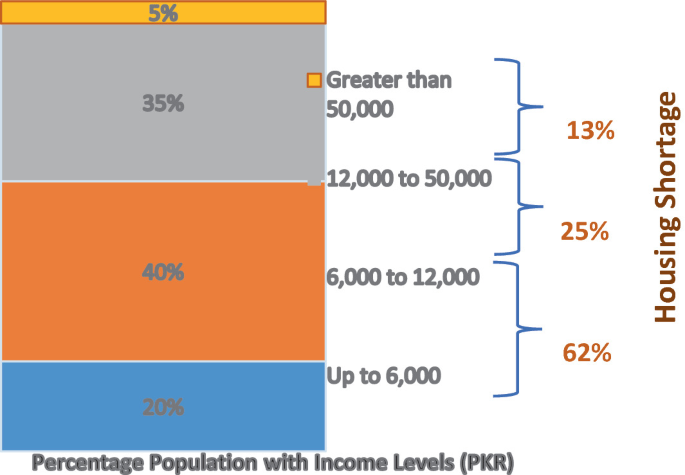Policies to Promote Affordable Housing in Pakistan Challenges and Lessons Learned
The document titled “Policies to Promote Affordable Housing in Pakistan: Challenges and Lessons Learned” provides a detailed examination of the current landscape of affordable housing policies in Pakistan, emphasizing the challenges faced in implementation and the lessons learned from past initiatives. It aims to inform policymakers and stakeholders about effective strategies to enhance housing accessibility for low- and middle-income populations.
Background
Pakistan is experiencing a severe housing shortage, with estimates suggesting a deficit of approximately 10 million housing units. Rapid urbanization, population growth, and rising property prices have exacerbated the situation, making it increasingly difficult for low-income families to secure adequate housing. The government has recognized this pressing issue and has initiated various policies aimed at promoting affordable housing. However, the effectiveness of these policies has been mixed, prompting a need for critical evaluation.
Key Policies
The report outlines several significant policies that have been implemented to address affordable housing in Pakistan:
- Naya Pakistan Housing Program (NPHP): Launched in 2018, this initiative aims to construct five million affordable housing units for low- and middle-income families. The program encourages private developers and financial institutions to participate in addressing the housing deficit.
- Mera Pakistan Mera Ghar (MPMG): This program, in partnership with the State Bank of Pakistan, provides affordable financing options for homebuyers. It seeks to make homeownership more accessible by offering low-interest loans to eligible families.
- Public-Private Partnerships (PPPs): The document emphasizes the importance of engaging the private sector through PPPs to leverage resources and expertise in delivering affordable housing projects.
Challenges in Implementation
Despite the government’s efforts, several challenges hinder the successful implementation of affordable housing policies:
- Land Availability and Costs: The scarcity and high costs of land, particularly in urban areas, pose significant barriers to developing affordable housing projects. Many initiatives are located on the outskirts of cities, where infrastructure is often underdeveloped.
- Bureaucratic Hurdles: Complex regulations and lengthy approval processes can delay project timelines and increase costs, discouraging investment from developers.
- Access to Financing: High interest rates and stringent lending criteria limit access to credit for low-income families, making it difficult for them to afford homes even with government assistance.
- Quality Concerns: Many existing affordable housing units lack essential amenities and infrastructure, leading to dissatisfaction among residents and undermining the goals of these policies.
- Coordination Among Stakeholders: Effective collaboration between various levels of government, private developers, and community organizations is often lacking, resulting in fragmented efforts that do not adequately address the housing crisis.
Lessons Learned
The report highlights several lessons learned from past initiatives that can inform future policies:
- Community Involvement: Engaging local communities in the planning process can lead to better-designed solutions that meet their specific needs and foster a sense of ownership among residents.
- Flexibility in Policy Design: Policies should be adaptable to changing market conditions and community needs. This flexibility can enhance their effectiveness over time.
- Integrated Approaches: Addressing housing affordability requires a holistic approach that considers related issues such as transportation, employment opportunities, and access to services.
- Monitoring and Evaluation: Establishing robust monitoring systems can help assess the impact of policies and identify areas for improvement. Continuous evaluation is crucial for ensuring that initiatives remain relevant and effective.
Recommendations for Future Action
To improve the effectiveness of affordable housing policies in Pakistan, the document offers several recommendations:
- Enhance Financial Support: Increasing funding for affordable housing initiatives is essential. This includes expanding access to low-interest loans and grants for developers focused on affordable projects.
- Streamline Regulations: Simplifying zoning laws and reducing bureaucratic barriers can expedite project approvals and lower costs for developers.
- Promote Sustainable Practices: Encouraging environmentally friendly construction methods can reduce long-term costs for residents while contributing to sustainability goals.
- Strengthen Public-Private Partnerships: Leveraging the expertise of private developers through PPPs can enhance resource mobilization and project delivery.
- Focus on Quality Standards: Ensuring that affordable housing meets minimum quality standards is vital for resident satisfaction and long-term success.
Conclusion
In conclusion, “Policies to Promote Affordable Housing in Pakistan: Challenges and Lessons Learned” underscores the urgent need for effective strategies to address the growing housing crisis in Pakistan. By learning from past experiences and implementing comprehensive policies that prioritize accessibility, sustainability, and community engagement, stakeholders can work towards creating a more equitable housing landscape that meets the needs of all citizens. The report emphasizes that achieving affordable housing is not just a matter of providing shelter; it is essential for fostering social stability, economic development, and improved quality of life for millions of people across Pakistan.

Further reading: Socio-Economic determinants on affordable housing in hilly areas of Pakistan
Affordable Housing Policies in Pakistan acash.org
Affordable Housing in Pakistan: Challenges and Solutions- IIPS iips.com


Major thanks for the post.Much thanks again.